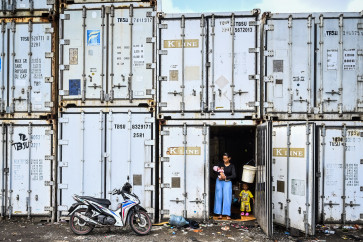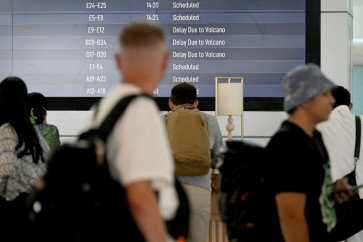Popular Reads
Top Results
Can't find what you're looking for?
View all search resultsPopular Reads
Top Results
Can't find what you're looking for?
View all search resultsDengue infection: What should we know and do?
Dengue fever is a major public health problem in Indonesia
Change text size
Gift Premium Articles
to Anyone
D
engue fever is a major public health problem in Indonesia. Every year we hear about dengue cases and some of them end in fatalities. This tropical infectious disease occurs due to infection by a virus named dengue, which has four serotypes (DEN-1, DEN-2, DEN-3 and DEN-4).
It is transmitted by the bite of the Aedes mosquito. Dengue fever was first reported in Jakarta and Surabaya in 1968. The highest number of dengue case on record was in 2007, with 150,000 cases nationwide and more than 25,000 cases reported in Jakarta and West Java. The fatality rate was around 1 percent.
Dengue fever is widespread in urban and rural areas in all provinces in Indonesia. This tropical disease usually has an annual peak during the rainy season for there are a lot of containers, dry tires and pots filled with rainwater about, which serve as breeding grounds for the Aedes mosquito.
Once inoculated, dengue has a 3-14 day incubation period. Following the incubation period, the patient may experience a sudden onset of high fever, chills, “bone breaking” aches in the head, back, arms and legs. The patient may also experience retroorbital pain, conjunctival redness, flushing of the skin, typical rash, nausea or vomiting, hemorrhagic manifestations such as nosebleed. The fever usually subsides after the third day.
However, this doesn’t mean that the patient has fully recovered. On the contrary, we should be more careful for the thrombocyte may drop and some complications such as inflamation of the liver, collection of fluid in the pleura, severe bleeding and fatal shock may occur. Some factors that determine the severity of the disease are the viral characteristics and the human immune response.
It is quite difficult to predict whether the complications occur so that for the patient’s safety it is commonly suggested that they be treated in a hospital, especially if their thrombocyte level rapidly drops and there are other warning signs (e.g. persistent vomiting, lethargy, mucosal bleeding, etc). A laboratory examination might show a decline of white blood cells, thrombocyte, and an elevation of transaminases. In the hemorrhagic form of the disease, a severe decline of thrombocyte and hemoconcentration may occur.
There are also other laboratory examinations to support the diagnosis of dengue. Dengue Non Specific (NS) Antigen 1 examination detecting the antigen of the virus, mostly shows positive results in the first to fourth day. Dengue IgM and IgG examinations are antibodies produced by the host immune system in response to the virus. A test that shows IgM indicates a recent infection, and positive IgG shows a past infection. Additional examinations such as chest X-Ray, abdominal ultrasonography (USG) may be done. Recovery is usually completed
within 7-10 days.
Dengue is a viral disease and theoretically it doesn’t need antibiotics for its treatment and no specific antiviral therapy is available. Fluid therapy is the main therapy in dengue to the importance of maintaining hydration as well as the management of the complications. Acetaminophen is the recommended drug to treat the fever and it also has an analgesic effect. The use of ibuprofen and other non steroidal anti-inflammatory drugs are not recommended. The clinical condition and laboratory examination should be thoroughly monitored every day.
Dengue infection is preventable. Preventing the transmission of the dengue virus depends on the control of Aedes mosquito and avoiding contact with the Aedes mosquito. There are several ways to eradicate the Aedes mosquito. Every time a dengue outbreak occurs, most people think that fogging should be done immediately to kill the mosquitos around them. This is not wrong, as fogging can kill adult mosquitos. Now how about the larva? Fogging cannot kill the larva of the mosquito. Most of us have heard of the “3 M” movement, which includes burying (Mengubur), draining (Menguras), and closing (Menutup).
These steps are cheap, easily done and an effective way to eradicate mosquitos, especially the larva. It since has been extended to “3 M Plus”, with the addition of several other ideas: keeping mosquito larva-eating fish, using larvacide, using mosquito nets when sleeping, using gauze, spraying insecticide, using repellent, examining for larvae periodically. Without active participation of the community, however, this powerful method will end up being merely a catchy slogan.
In Jakarta, people are asked to join and support such movement every Friday morning in order to eradicate mosquito larvae. The success of this depends on the active participation of the community and the continuity of the program. Of course, to prevent is better than to cure. The disease inflicts a health, social, and economic burden on our society. Several studies have shown that it costs a lot of money to treat the disease, and certainly it is far more expensive than the cost of doing “3 M Plus”.
We all hope for a dengue vaccine, and some live attenuated dengue vaccines are in advanced stages of development. But we don’t know how much the vaccine cost and when it will be available. Moreover, it is not wise for us to do nothing while we wait for the vaccine.
So now, should we just listen to the news of dengue cases and worry about it every year without doing anything to prevent it? It is not just the government’s or medical staff’s responsibility – it is our responsibility as members of the community to prevent and eradicate dengue fever.
The writer is a physician.










